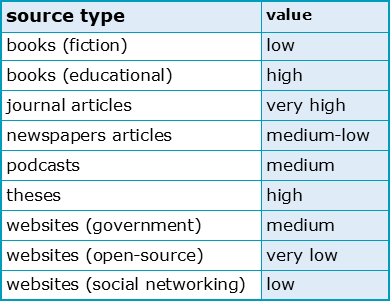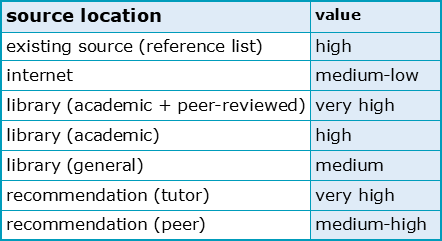How can I quickly identify academic source value?

This is the first of three chapters about Identifying Source Value. To complete this course, read each lesson carefully and then unlock and complete our materials to check your understanding.
– Introduce the concept of making quick value judgements
– Provide seven methods for judging source value at a glance
– Offer ways of categorising the value of different source types and source locations
Before you begin reading...
-
video and audio texts
-
knowledge checks and quizzes
-
skills practices, tasks and assignments
Chapter 1
While Academic short readers on finding academic sources and conducting digital searches have dealt more closely with understanding what a source is, why academics use them and how such sources can be best located through a university library, this three-chapter reader now focuses more specifically on the methods and processes that are necessary when identifying the value of a source. To guide your learning, Chapter 1 first focuses on the seven most important aspects for the quick identification of source value – which is a necessary skill when reducing search results to a manageable number for research. Once you’ve selected a reasonable array of sources, Chapters 2 and 3 then provide six questions that academics can ask themselves to determine whether or not a text is of sufficient appropriacy and quality to be used in an academic assignment.
Why are quick value judgements important?
When conducting research, it’s not only imperative that an academic is able to use search terms, search filters and Boolean operators within a library search engine to narrow a search, but it’s also critical that those academics can quickly determine which of the remaining results are going to be most useful and therefore which require closer inspection. While a hundred or so search results is a manageable number to make quick value judgements about, few researchers will be able to read or use all of these sources in their work. With this in mind, how will you know which sources to read in more detail? What can be done at this stage to efficiently identify the value of your potential sources? To answer these questions and assist you when researching, we’ve provided seven aspects below that should be considered if you wish to confidently know which sources require further investigation.
1. The Source Type
When presented with a manageable number of sources to sift through, the first aspect you should consider is regarding the kinds of sources you’ve located. Are the texts you’ve found books, journal articles, or online newspapers, for example. If using a university library to conduct your searches, you may have already adjusted your filters to find particular source types, but if attempting to use a public search engine such as Google or Baidu, you may have to be more careful here as not all source types are equally as effective for producing academic research.
Although we’ve included a table below that categorises ten of the most common source types by their academic value, if you would like to know more about identifying one source from another then please visit our short reader on finding academic sources. Regarding the following table, please note also that because the value of a source might be quite dependent on the topic and type of research being conducted, this diagram only offers generalisations about such value:

2. The Source’s Location
Also connected to our first point is some consideration of where you found the source you’re thinking of using. If it was an academic tutor that recommended that source for example, you could be fairly sure that the content would be appropriate and relevant to your research, but if you stumbled across that source on the internet then you should perhaps be fairly cautious about using it. The following table provides another set of useful generalisations, this time regarding source location:

3. The Publisher
After identifying the source type and where it’s physically or digitally stored, you may then wish to consider the publisher of the source you’re thinking of further investigating. Is that publisher a well known academic organisation that prides itself on delivering unbiased information for example, or is it one that will publish anything to maintain its sales and revenue? A little online investigation here (or some background knowledge) into the company that funds and sells that particular source may offer some illumination as to its possible academic value.
4. The Year of Publication
Depending on the topic you’re investigating and your field of study, the date of a source’s publication may also be of critical importance when making quick value judgements. An essay about connecting human brains to computers, for example, would likely benefit from very up-to-date publications, whereas an essay about the Latin language might find that it’s the more historical sources that are most suitable. Consider your topic, decide upon a range of publication years, and perhaps use those years as a filter in your library search engine to help quicken this process.
5. Your Search Terms
The next piece of advice for when making quick value judgements about sources is about making sure that the search terms you’ve selected match the sources you’ve found. As was explained comprehensively in our course on conducting digital searches, an effective researcher will learn to create noun-phrase based search terms and search strings that can be used to narrow a library search-engine’s results. If the sources you’ve found do not in any way match your list of relevant search terms, then perhaps consider discarding those sources altogether. Without a match, these sources probably lack relevance and appropriacy for your assignment.
6. The Source’s Keywords
Similar to point five is that some journal articles will provide a list of keywords that summarise their article and assist with indexing. These keywords are intended to concisely represent the most important themes contained within that research, and should therefore probably be checked by a researcher in advance of reading that source in more detail. Doing so will likely help an academic such as yourself determine whether or not a particular source is relevant and valuable.
7. The Quick-Access Content
Finally, never forget to practise your skills of skimming and scanning as they’ll likely help you determine the value of a potential source with speed and accuracy. By checking the source title and its contents list (if available), and by reading the abstract and looking over any images or graphs, a researcher is often able to quickly decide whether or not a particular source is worth reading in more detail. The abstract of a journal article in particular offers ample information as to the overall contents of a source and as such should be read more thoroughly than other parts.
Having now discussed the seven key aspects of how to determine source value at speed, Chapters 2 and 3 next focus on forming the deeper perceptions of a text – such as judgements of its overall appropriacy and quality for academic research.
Downloadables
Once you’ve completed all three chapters about identifying source value, you might also wish to download our beginner, intermediate and advanced worksheets to test your progress or print for your students. These professional PDF worksheets can be easily accessed for only a few Academic Marks.
Collect Academic Marks
-
100 Marks for joining
-
25 Marks for daily e-learning
-
100-200 for feedback/testimonials
-
100-500 for referring your colleages/friends